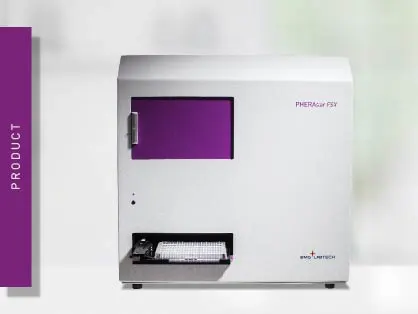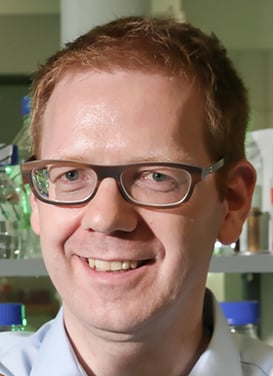
PHERAstar FSX
Powerful and most sensitive HTS plate reader


Discover how high-throughput screening of cyclic peptide libraries with BMG LABTECH readers accelerates drug development for challenging targets.

Professor Christian Heinis explains how peptides could offer the next generation of therapeutics and what is required to screen libraries of cyclic peptides.
Your lab is known for the development of cyclic peptides as drugs. How do they differ from conventional compounds and what are their benefits?
Cyclic peptides have excellent binding properties, allowing them to bind to targets with flat, featureless surfaces for which it can be difficult or impossible to develop ligands based on classical small molecules. Another strength of cyclic peptides is their typically low toxicity due to their high target specificity and because their degradation results in amino acids. Yet another advantage of cyclic peptides is the availability of powerful techniques to develop them, for example, phage display or solid-phase peptide synthesis.
A long-standing goal of the pharmaceutical industry has been the development of peptides that can be taken as a pill. How far away are we from this approach?
This is quite challenging as peptides need to resist the aggressive proteases present in the gastrointestinal tract and they have to cross the epithelium to enter into the blood stream for travelling to disease targets. There are examples of peptides from nature that are orally available, showing that this is possible in principle. I am optimistic that it will become possible in the coming years to generate small cyclic peptides that act on targets of interest and that can be taken as a pill. My laboratory at Ecole Polytechnique Fédérale de Lausanne (EPFL) has recently established an approach for the combinatorial synthesis of 10,000s to 100,000s of small, membrane permeable cyclic peptides in 1536-well microplates and we hope that this will help in developing oral peptide drugs.
Your work involves generating and screening large libraries of cyclic peptides. What role do microplate readers play in this?
Essentially, all assays used to measure target engagement of molecules are performed in wells of microtiter plates and thus require microplate readers. We use microplate readers every day, sometimes to measure the activity of only a handful of peptides and sometimes for screening a library of up to 100,000 cyclic peptides. In these experiments, different signals are measured, ranging from fluorescence intensity, over fluorescence polarisation to time-resolved fluorescence energy transfer (TR-FRET). Similarly diverse are the formats of microplates that we use, ranging from 96-, over 384- to 1536-well plates.
You recently invested in a PHERAstar® FSX plate reader. What criteria did you use in your evaluation and which requirements are needed to keep up with your necessities?
For us, it was important to have a flexible system that can read the properties described above and thus is applicable to many different biological assays. This was important as we work regularly with new targets that require other types of assays. Other criteria were that the microplate reader can deal with all types of plates including 96-, 384- and 1536-well plates, that it can be integrated into our automation platform and that it is fast and robust enough for high-throughput screens. Based on these criteria and technical specifications, we have evaluated instruments in our lab, using the most common assay formats described above. The PHERAstar FSX showed excellent sensitivity, speed and robustness for all assay types and was convenient to use. We have recently added an additional option for also measuring TR-FRET, which was easily possible as the instrument is modular and allows upgrading.
Christian Heinis studied chemistry/biochemistry at the ETH Zurich. After a PhD in the research group of Professor Dario Neri at ETH Zurich, he completed two post-docs, the first with Professor Kai Johnsson at the Ecole Polytechnique Fédérale de Lausanne (EPFL) in Lausanne and the second with Sir Gregory Winter at the LMB-MRC in Cambridge, UK. Since 2008, he has been Professor at the EPFL. Christian is co-founder of the company Bicycle Therapeutics. He is co-director of the Swiss research network NCCR Chemical Biology.
The interview was firstly published on drugtargetreview.com
Powerful and most sensitive HTS plate reader